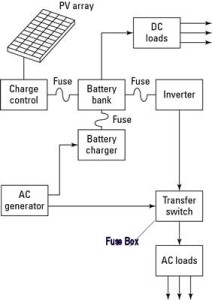It could change how you camp forever!
By Chris Erwin
When most people talk about off–the-grid living, they usually talk about a cabin in the deep woods with solar panels as the only option to living with power.
However, much has changed in the world of solar, winds and other more passive forms of producing power. If you camp in an RV, pull-behind camper, if you have a camper on lake, river or stream or maybe you have a boat moored on a lake or river. All of these options can benefit from learning how use-off-the-grid power methods to reduce the need for petroleum fuels.
I have been staying off the grid for over 30 years on fishing and hunting trips, along with just getting away for the weekend to my cabin. The one thing that has always been a sore spot was listening to a generator run in order to provide the needed power to run things on a trip.
In this article, I want to limit our discussion to “off-the-grid” systems. We could also talk about “grid-tie systems,” which are system that tie right into the grid. They feed power back into the grid and usually don’t use batteries, but these are for in-town homes and with my space limitation, we will limit our coverage to off-the-grid systems.
To make this easy to understand we need to start at the end, meaning the last step in any off-the-grid system. That is our power source. Contrary to what some people think, it’s not the solar panel. It is, however, a battery or batteries depending on the size of your system.
Batteries store our fuel, and the amount of our needs start with how much storage is necessary to provide us with power while we stay off the grid. You can scale this to your particular needs.

To make the DC power useful for an AC application, we need an inverter. This is a device that converts DC power to 60-cycle AC power. These units come in sizes from 100 to 50,000 watts, so your needs come down to simple math. You need to add up the usage of the articles you intend to run and then make sure you purchase enough to run all of your electrical needs.
There is another thing to consider: These inverters come two ways, modified sine wave and pure sine wave. I could go into the clipped oscillations of the sine wave, but to save space Let’s say it this way: If you run a lot of sensitive electronics, you need a pure sine-wave inverter. It produces the same electronic current you have in your house, while the modified sine wave will run anything using AC current, however, this less-expensive option can affect things like computers, TV’s and some DVD players. While I have run all of these on M-sine wave inverters without issue, it has been reported from many sources that it can damage them.
The Inverter is connected to the batteries (the source of our power), and then it can be plugged in directly to run AC appliances, or it can go to a fuse box where the house, boat or camper is wired in a traditional manner.
The solar panels are placed in a sunny location most of them today are made to be daisy chained together. They connect to a box called a charge controller. This device is like a regulator. It charges the battery according to its needs and once the battery reachs full charge it shuts off the voltage to the batteries. Some can even switch to “shed lights” or other appliances just to burn off unneeded power.
You can add a generator to the system as a back up to supplement on dark cloudy days. In my drawing, you can see where the generator would be placed in the system. On a permanent system you would put disconnect breakers so while isn’t needed is not connected to the system.
As you can see DC power could come directly from the battery array, while AC power would come from the inverter. This is how the system works in its simple’s terms.
Your needs as far as how many batteries you need should be enough to run your needs using only 50 percent of batteries or less, and your solar needs should be enough to recharge your batteries before they dip below 50 percent. This figure is going to be different for every application.
Batteries should be at least deep cycle batteries. However, today batteries are produced just for this application and are rated in Amp-hours.


Be the first to comment